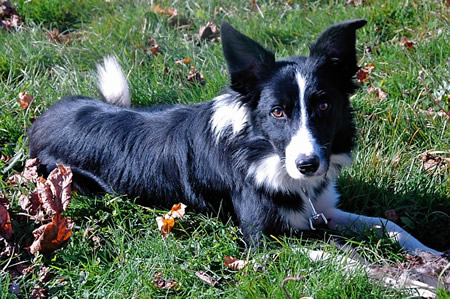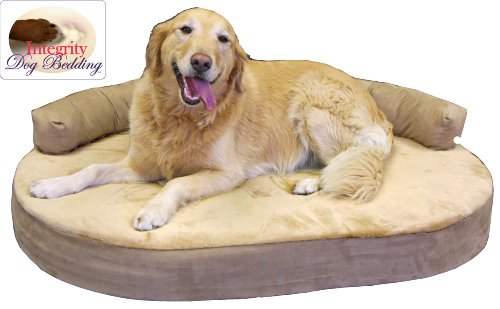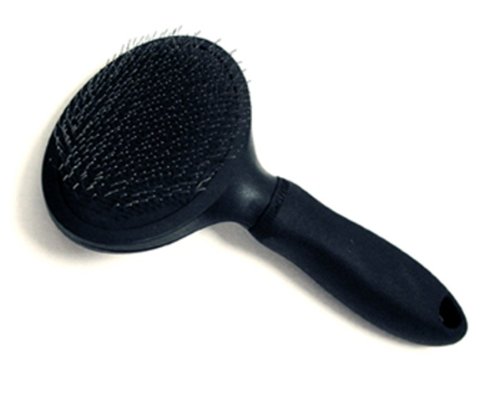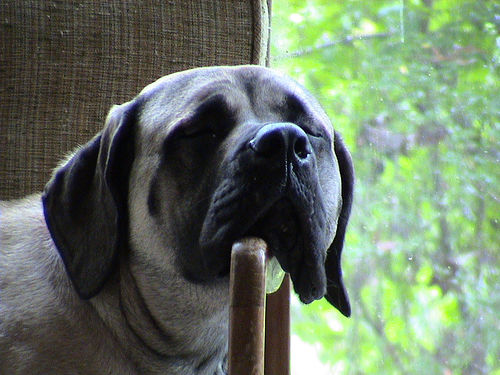
I had never heard of a dewclaw on a dog until I started looking for a Labrador Retriever puppy. As I researched various litters of puppies, I noticed that some breeders removed the dewclaw. It turns out that a dog’s dewclaw is an extra digit most commonly found on a dog’s front legs and sometimes called the dog’s thumb. If your dog has one, it will be on the inside of its leg, a little higher up from the dog’s paw. It is possible for dogs to also have a dewclaw on their hind legs or occasionally more than one dewclaw on the same leg.
 The dewclaw is a genetic structure that appears to have lost most of its ancestral function since it's located high on the foot, not touching the ground. However, there are 5 tendons attached to the dewclaw and 5 muscles that work with those tendons. The dewclaw does touch the ground when some dogs run which appears to help with traction. In addition, dogs can use these claws to help hold items with their paws.
The dewclaw is a genetic structure that appears to have lost most of its ancestral function since it's located high on the foot, not touching the ground. However, there are 5 tendons attached to the dewclaw and 5 muscles that work with those tendons. The dewclaw does touch the ground when some dogs run which appears to help with traction. In addition, dogs can use these claws to help hold items with their paws.
One of the main reasons for removing the dewclaw in some breeds such as Labrador Retrievers is to avoid injury that may occur from a dewclaw catching on rough terrain causing a tear or rip of the appendage. This is especially true for hunting dogs since they regularly run through thick grass, jump into lakes, and flush birds from cover. However, most veterinarians say these
 injuries are not very common and heal with normal treatment if they occur. If the dewclaw is not removed then it is important to keep the nail trimmed which also lessens the potential of an injury occurring.
injuries are not very common and heal with normal treatment if they occur. If the dewclaw is not removed then it is important to keep the nail trimmed which also lessens the potential of an injury occurring.
There is some interesting new research being done about the role of the dewclaw preventing torque to the dog’s leg. The findings show that when a dog is running and then turns, the dewclaw digs into the ground providing support to the lower leg. In dogs without a dewclaw, the same scenario causes the dog’s leg to twist. In athletic dogs,
 this twisting over time has led to carpal arthritis or injury to other joints such as the elbow, shoulder, and toes. By removing the dewclaw, the muscle groups associated with the dewclaw shrink from disuse. It’s believed that the pressure normally absorbed by the muscles in the dewclaw travels to other parts of the leg resulting in long-term problems such as arthritis.
this twisting over time has led to carpal arthritis or injury to other joints such as the elbow, shoulder, and toes. By removing the dewclaw, the muscle groups associated with the dewclaw shrink from disuse. It’s believed that the pressure normally absorbed by the muscles in the dewclaw travels to other parts of the leg resulting in long-term problems such as arthritis.
It appears that the removal of the dewclaw is becoming less common as we learn more about possible benefits. Even in hunting situations, the dewclaw can turn into an asset. Dogs that hunt in the winter are at risk of falling through the ice on frozen lakes. I’ve seen video footage showing dogs with their dewclaws are much more effective at pulling themselves out of the icy water, than dogs without them. The dogs use the dewclaw to dig into the ice and then are able to pull themselves out of the water on to the ice. For those dogs, having dewclaws might save their lives.
 Interview With A Border Collie Rescuer
Interview With A Border Collie Rescuer
Border Coll
Interview With A Border Collie Rescuer
Interview With A Border Collie Rescuer
Border Coll
 Is Rice Laced With Arsenic?
Credit: Copyright of iStockphoto. Licensed to
Is Rice Laced With Arsenic?
Credit: Copyright of iStockphoto. Licensed to
 Caring For a Golden Doodle
Credit: www.pixabay.com
Caring For a Golden Doodle
Credit: www.pixabay.com
 How to Treat and Prevent Infected Wrinkles in Wrinkly Dog Breeds
In humans, wrinkles are a us
How to Treat and Prevent Infected Wrinkles in Wrinkly Dog Breeds
In humans, wrinkles are a us
 10 Dog Breeds For Laid Back Lifestyles
10 Dog Breeds For Laid Back Lifestyles
Make Room On The
10 Dog Breeds For Laid Back Lifestyles
10 Dog Breeds For Laid Back Lifestyles
Make Room On The
Copyright © 2005-2016 Pet Information All Rights Reserved
Contact us: www162date@outlook.com